1969 BMW 2500 Automatic E3
When Chris Goddard bought this 2500 it was in a sorry state but after a lengthy restoration it’s back on the road and better than ever.
Words: Bob Harper
Photography: Greg Evans
E3 2500 Restored classic BMW
“If design could be taught by example we would campaign all the British manufacturers of luxury cars to investigate the BMW six-cylinder range. Seldom have we tested a new model with so much good about it and which impressed us so easily. From simple details like the instrument panel and the seat material to fundamentals like the exemplary engine-transmission combination, this is a superbly satisfying car to own and drive.” High praise indeed for the BMW 2500 from Autocar when it first tested the car in 1969.
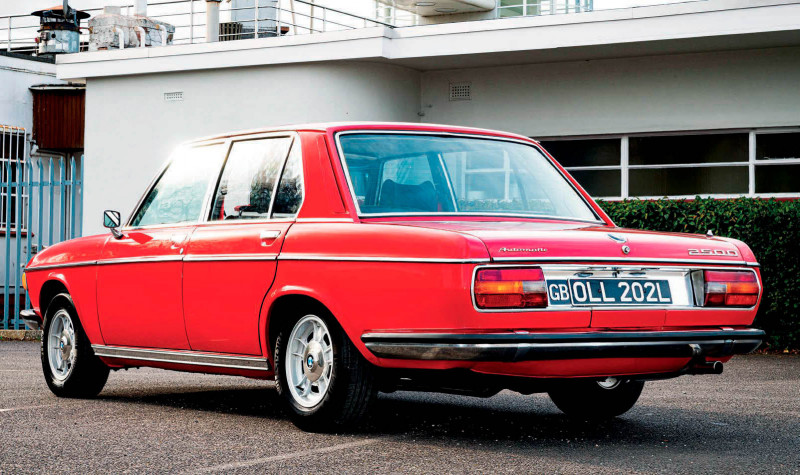
The ‘New Six’ or as BMW referred to it, the ‘big BMW’ (it was never officially referred to as the E3 by BMW in its brochures or advertising), was launched in 1968 as the 2500 and this was soon joined by the 2800 while in the 1970s 3.0- and 3.3-litre engines were added, some with fuel injection, along with long wheelbase models, too. The Autocar review wasn’t a flash in the pan either, with the vast majority of the motoring press fawning over BMW’s new saloon. There was one problem though, especially in the UK, and that was the E3’s high price. Once import duty had been added it was £600 to £700 more expensive than a Jaguar XJ6 and given in the late ‘60s the Jag cost around £2500 the price hike to get behind the wheel of the BMW was a significant chunk of change.
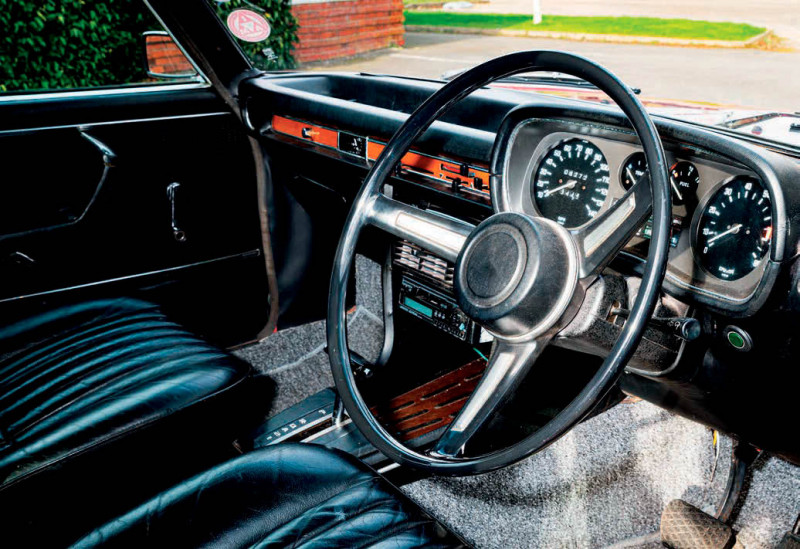
Of course, at the same time as the E3 was introduced BMW also launched the E9 CS Coupé and while the stylish saloon was quite a looker it perhaps didn’t quite have the even more svelte style of the pillarless two-door. The Coupé was even more expensive though and this coupled with its less practical nature ensured the E3 outsold it by quite a margin. By the time the two models ended production in 1975 (E9) and 1977 (E3) BMW had delivered around 30,000 Coupés and 222,000 Saloons but despite this there’s no doubt over which is the rarer car today, especially in the UK – when was the last time you saw an E3 Saloon on the road?
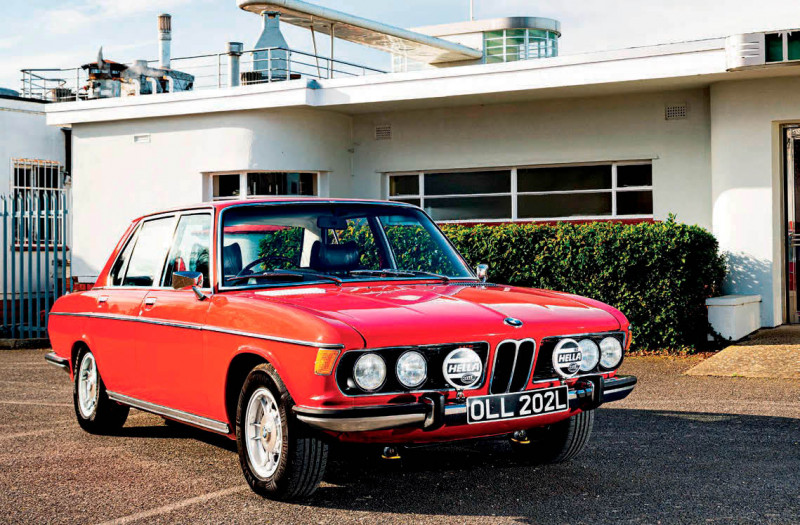
For those of us who have a penchant for saloons it’s a sad fact that there always seem to be more people who are drawn in by the sexier two-door styling of the coupé which means they are more valuable. And as a result they’re worth more and much more likely to be saved from the dreaded scrap heap and while a rusting hulk of a coupé will still sell for strong money a decent, usable E3 will struggle to match that. The sad fact is that even today restoring an E3 Saloon isn’t going to be a financially viable proposition if you need to pay someone else to do the work. But if you can take a leaf out of Chris Goddard’s book you might just be able to end up with an E3 that’s as gorgeous as this one.
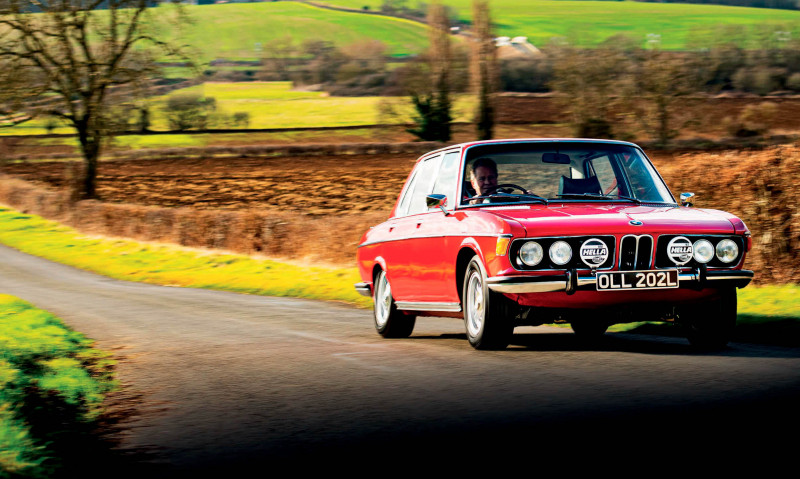
Chris has been a BMW fan for longer than he cares to remember and today his stable includes a brace of Alpinas – a B10 and a B5 – along with an E93 M3 Convertible and the E3. Recently departed models from his collection include a pair of E24 635CSis, two E36s and an E46 too. We think it’s safe to say he’s got the BMW bug. It all started back in the 1970s as Chris relates; “Back in the ‘70s my dad had an E9 Coupé and that was back when everyone drove Jaguars – nobody knew what a BMW was! One of his salesman had a new Ford Granada at the time and after a good year the salesman asked whether he could change his car the end of the year as he really, really wanted one of those four-door BMWs and I think he got an E3 3.3. We used to go to Carlisle on business in it and we went at high speed all the way. It was just fabulous. We’re very much BMW fans – I got my first one in 1975, a 2002tii, and I’ve had plenty more since then.”
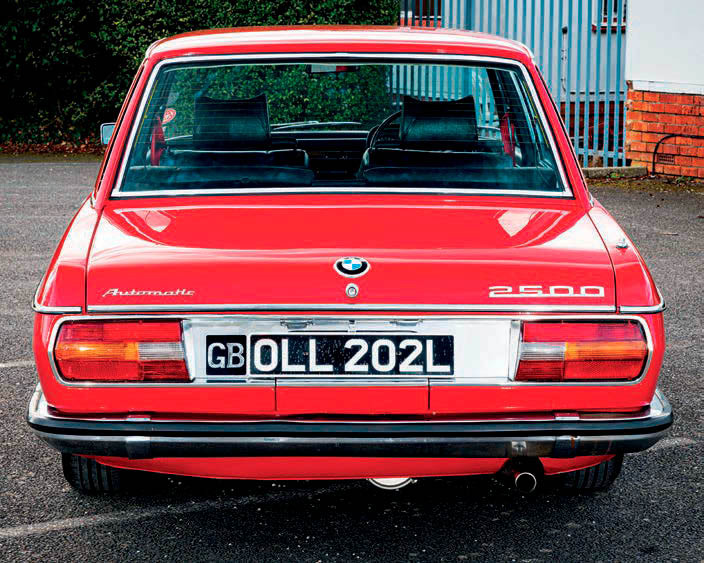
Chris is in the warehousing and self-storage business and few years ago he built a workshop and garage facility on a site just opposite his business premises, replacing an older shed in which his friend Paul Lucking had been restoring cars. Paul had already worked on several cars for Chris and when he came across an advert for an E3 2500 project on eBay he sent a link to Paul to ask for his opinion on it. They came to the conclusion that if it could be bought for the right price it would make for a great project for Chris to work on with some guidance from Paul.
“I wanted the 2500 to be as good as it could be but I also wanted it to still be usable”
“We decided that if we could buy it for less than £5k it would be a good project,” comments Chris, “and in the end we got for considerably less than that. The guy I bought it from had had it in his garage for 12-years and he had been trying to restore it himself. When I went down to pick it up the first question we asked was ‘does it run?’ He said that it had been driven into the garage 12-years ago so after we’d trailered it back up here to Northamptonshire we got it in the workshop to see if it would run. The first thing we did was connect a battery and a small fuel tank, sprayed in some Easystart and it fired up immediately! We though, hooray, we don’t need to take the engine apart!”
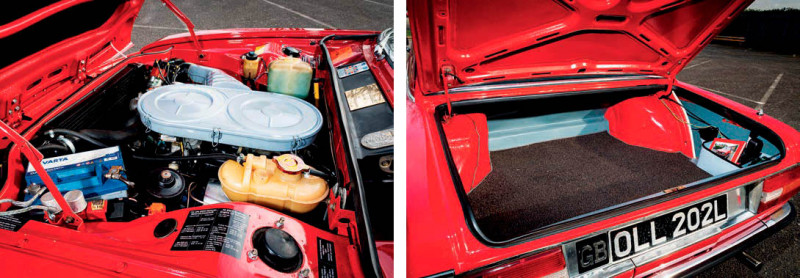
The engine did come out though as Chris and Paul stripped the entire car down to its shell so it could be sent away for painting. Just to double check the top and bottom ends of the engine were examined while it was out of the car but as everything looked to be in great shape they decided to leave it at that and it’s been fine since, bar an oil leak that’s been hard to track down. “Every time we fix one leak another one appears!” says Chris with a frustrated grin.
However, while the engine didn’t need to be dismantled when Chris first got the E3, it had a single carb on it that was incorrect. The original twin carbs came with it but they were in a box as they’d obviously stopped working correctly at some point in the past. Chris and Paul got it running on the single carb and as a project they rebuilt the twin carbs while the shell was away for painting and they’re now on the car but Chris does say that setting them up was a bit of a challenge.
Once the 2500 was stripped down to its constituent parts the shell was sent away for a few corrosion related items to be sorted before being resprayed. “It was very solid in the first place,” Chris tells us, “But behind the outer headlights the water gets in and sits there and it had rotted quite badly and someone had repaired it in the past with fibreglass and filler! We wanted to do it properly and Jaymic were able to get the parts to repair that but they were hugely expensive but it’s obviously worth doing properly. There was some rust around the arches which was all cut out and repaired properly, too. It took ages for it to come back from the paint shop and I did change the colour very slightly. Originally it would have been Verona Red but I used a more modern BMW colour – Karmesinrot. I thought Verona looked a little bit too much like Post Office red so I changed it to this and I’m very pleased with the end result.
“Once we got it back we started putting it all back together and one of the biggest problems with the car was knowing exactly how to put it back together because the guy before me had taken some of it apart. It was hard at times working out what went where, you’d say, ‘hang on a minute, this side had two seals on the suspension but the other side had three – which one’s right, how many should there be?’ In the end we got a microfiche to work out exactly what we needed and what went where.”
Finding out where to get parts from was difficult too, but Chris ended up buying most of the spares from Jaymic who he was impressed with. “Some parts were hard to come by, but Jaymic were really, really good,” Chris says, “And if they haven’t got it they have contacts in Germany who were able to get things for the restoration. Every week a little parcel would arrive from Jaymic and we seemed to be running at about £500 a week for some time as we accumulated new parts!”
As with most restorations there were hiccups and challenges along the way. A new screen had to be ordered from Pilkington Glass which too several months to make and getting the brakes right was a challenge too. It’s got brand new calipers on the front as the old ones were too far gone, but the new ones were quite hard to find, and even when they had been fitted Chris and Paul struggled to expel all the air from the system no matter what they tried. Eventually they concluded that the servos needed overhauling so they sent them away for repair. Unfortunately the company came back to them and said they were beyond economical repair and that they needed new ones which was another large expense.
Some parts are almost impossible to find new as Chris relates; “The other parts that are really hard to get hold of are bumper parts and even if you can find some they’re astronomically expensive. If I was being picky I’d have the rear bumper rechromed but I quite like the patina of the ones on the car. While I wanted the 2500 to be as good as it could be I also wanted it to still be usable so I’m happy to stick with the original bumper.”
While the E3 has been restored almost exclusively to its standard specification Chris has changed and improved a couple of things. The suspension is now poly bushed and it’s sitting on Bilstein shock absorbers and he reports that the ride is “fabulous and so comfortable.” It also sports an interior from another E3 as there was very little left of the original cloth interior. The previous owner managed to find a leather interior from a 3.0-litre car and Chris feels this is a big improvement even if it’s not correct from an originality point of view.
When Chris took possession of the E3 it was running on steel rims with chrome hubcaps so he decided to look for some alloys to improve the car’s looks. “I found this set on eBay,” he tells us, “that were being sold by a chap in London on eBay. They were collection only and I think this was putting people off so I contacted him and did a deal with him. He wheeled the wheels and tyres out and they were like brand new! Turns out he’d bought an E9 but didn’t like the wheels so he put a set of Alpina wheels on it which allowed me to get these that didn’t need any restoration with new tyres at a good price.” We reckon it was worth the trip to London as they look superb on the car and finish it off nicely.
Understandably Chris is delighted with the fruits of his and Paul’s labours. “It’s literally been a nut and bolt restoration – apart from the engine – and I think it looks immaculate. I’m pretty sure that all’s that left to do is sorting the oil leak and fixing the radio,” Chris says. The plan is to be able to do some touring holidays in the car but so far the first trip didn’t go quite according to plan; “I did one rally in it,” recounts Chris, “and unfortunately it wasn’t charging properly so it petered out after 15- miles and stopped – the one light on the dash that didn’t work was that one!” Despite this Chris feels a real affinity for the E3 as he really has put his heart and soul into its restoration.
He does accept that it hasn’t been a cheap exercise. “I think to date it stands me at about £20k which is what it has cost me to get it where it is. And that’s without my labour and Paul’s labour – restoring cars is not a cheap business. If I’d been paying for labour then I should imagine it would have cost about £40k!” They weren’t cheap cars when they were new though, and even if its restoration has been costly it would look like it was certainly worth it. They’re great cars and deserved to be saved. As Autocar concluded in its original road test; “Few car have impressed us so much and few cars are so good in so many of their dynamic features.” So take a leaf out of Chris’s book and save an E3 today!
The engine hadn’t been run for 12- years but it fired straight away much to everyone’s delight. The suspension has been fully poly bushed and now sits on fresh Bilstein shock absorbers.
TECHNICAL DATA FILE 1969 BMW 2500 Automatic E3
- ENGINE: M30 six-cylinder, 12-valve
- CAPACITY: 2494cc
- MAX POWER: 150hp @ 6000rpm
- MAX TORQUE: 159lb ft @ 3700rpm
- 0-62MPH: 10.4-seconds
- TOP SPEED: 118mph
- ECONOMY: 26mpg
- WEIGHT: 1360kg
- PRICE: £3056 (1969)
The car’s restoration has been a labour of love for Chris and his friend Paul.
The colour was changed very slightly from Verona Red to Karmesinrot – a modern BMW hue.
Leather interior from a 3.0-litre car replaced the original cloth inners as they were in a sorry state.
Chris and Paul stripped the entire car down to its shell so it could be sent away for painting


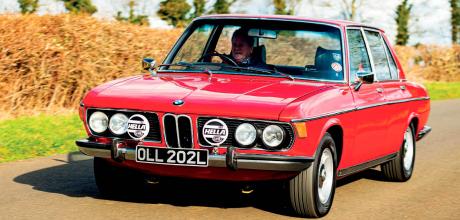
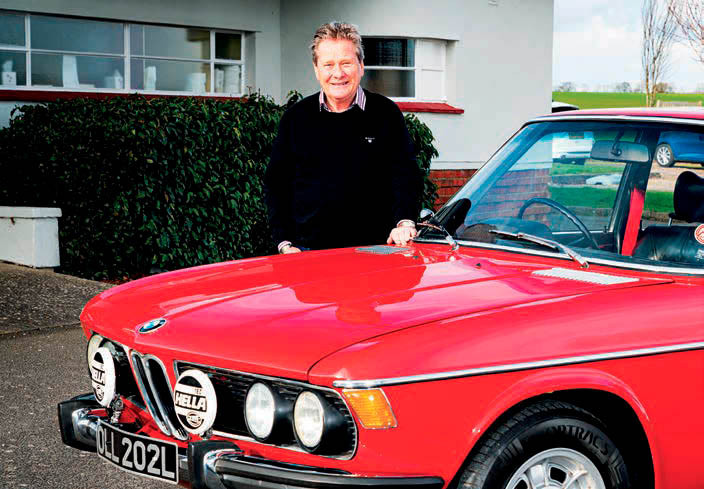
Taking on the restoration of a classic BMW is often not for the faint of heart. Increasingly out-and-out classics from the 1960s and 1970s require more than a little TLC if they have not been maintained fastidiously over the years by careful owners. It's easy to forget that we're talking about cars that are now 50- years old – if not more. When Chris Goddard bought his E3 it was in need of much attention and to the credit of Chris, following a lengthy restoration, it is now a shining example of the breed. Without owners like Chris going above and beyond we might lose cars like his 2500 forever, that would be a terrible shame. Discover just what goes into restoring an old BMW on.
The bright red E3 got me thinking about this month's instalment of our ongoing celebrations marking 50-years of BMW M – this time the 1990s. While the preceding decade certainly gave us some enduring classics, this period in time delivered a batch of exceptional performance BMW road cars – think E36 M3 and E39 M5 to name just two. Once again for those of us at a certain age it's easy to forget that the cars from this period are also getting on a bit now, even the youngest is over 20-years old. That's in part why we're seeing values on a sharp incline of late as these sought after and often iconic BMWs age, reduce in number and fall into the hands of those who wish to preserve them rather than abuse them. It is not my money on the line, but a balance of preservation and use is an ideal mix in my view, but how about you?
Restoring a classic BMW is a labour of love...
E3 Love
I loved Chris Goddard’s E3. Thanks to people like Chris restoring cars that are (at least on paper) uneconomical to restore to that level, BMW enthusiasts like me get to enjoy models that would otherwise slip away into the history books.
Values of cars like the E3 are yet to reach the levels they often need to in order to make full restorations pay-off – if you are looking to recoup your investment, but classic BMW restoration isn’t always about that, thankfully. Restoring cars like these is more about the journey, the fun that is had along the way, and preserving them for future generations.
I have restored a few classic BMWs in my time and I never add-up what a project has cost as for me it’s more about enjoying the hobby than balancing the books. Maybe I am in a fortunate position but I for one prefer to see cars restored by genuine enthusiasts – like Chris – for their own pleasure, rather than those restored in order to break even or make money on. Well done to Chris and his friend Paul Lucking on a job well done!